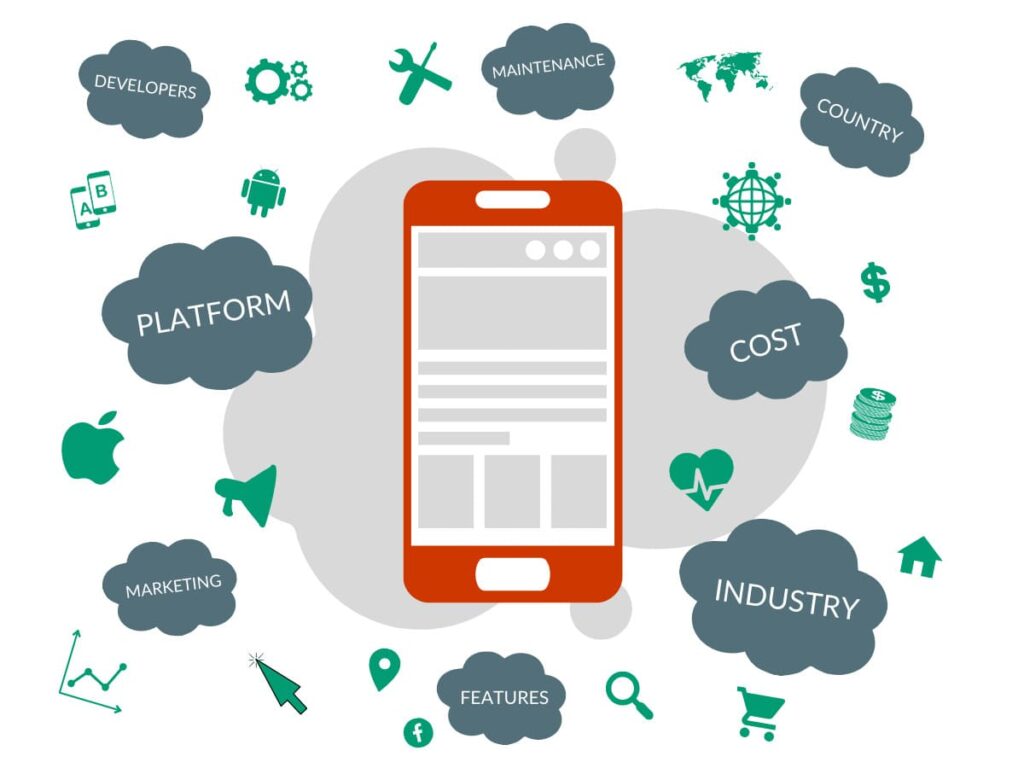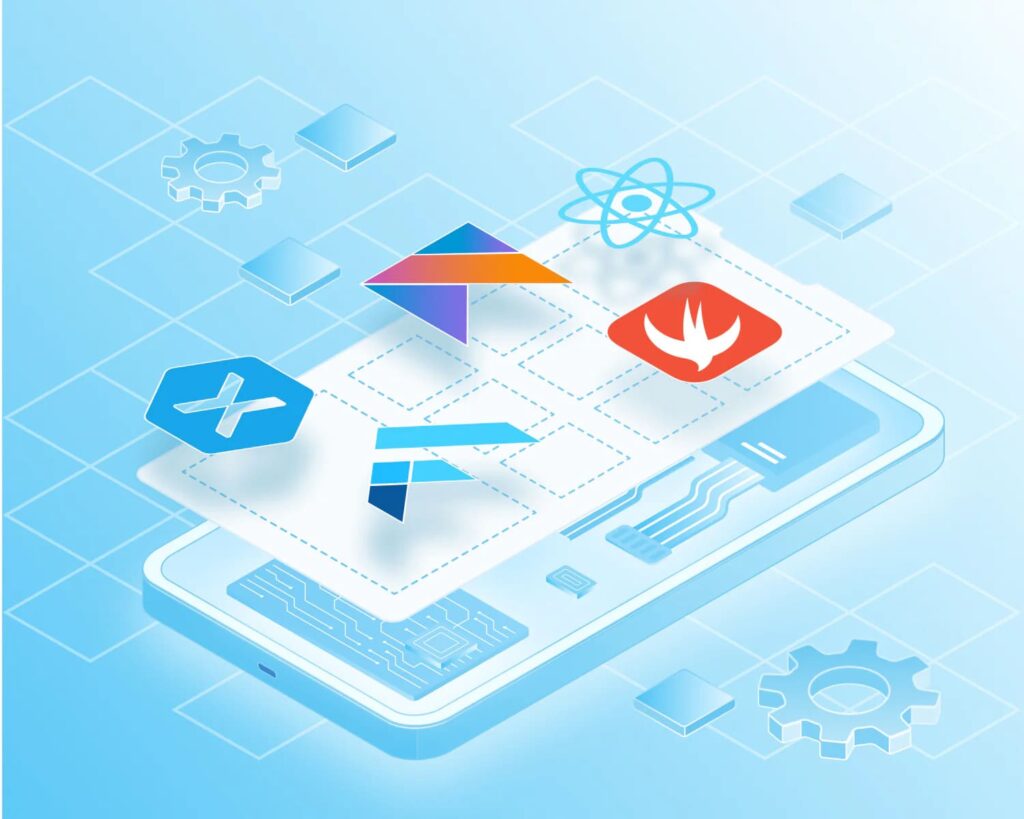As the mobile app market continues to grow rapidly, the demand for high-quality, innovative applications has never been higher. Therefore, estimating app development costs can be a significant challenge for businesses and entrepreneurs.
Balancing the need for cost-effective development with the requirement for exceptional quality and user experience is a delicate task that every mobile app project must navigate.
In this article, we’ll go on a journey with businesses and entrepreneurs to find a solution to optimize app development cost-effectively.
Which 6 Factors Affecting Mobile App Development Costs In 2024?
The process of doing mobile app development cost estimates can vary significantly depending on a range of factors. Understanding these key drivers of app development cost is crucial for organizations to effectively budget and manage their mobile app projects.

#1: Platform (iOS, Android, or cross-platform)
The choice of platform is a primary factor in determining the development costs. Building a native app for iOS or Android requires specialized skills and toolsets, which can be more expensive than developing a cross-platform app using frameworks like React Native or Flutter. However, native apps often offer better performance and a more seamless user experience.
#2: App Complexity (Number of Features, UI/UX Design, Integrations, etc.)
The complexity of the app plays a major role when considering mobile app development costs. Apps with a larger number of features, intricate user interfaces, user experience (UI/UX) designs, and extensive integrations with third-party services will generally require more development time and resources, resulting in higher costs.
#3: Development Team (In-house, Outsourced, or Freelancers)
The composition of the development team can significantly impact the overall project costs. Hiring an in-house team of skilled developers may be more expensive upfront but can provide greater control and continuity.
Outsourcing development to a third-party provider or working with freelance developers can be more cost-effective, but may require additional oversight and coordination.
#4: Development Process (Agile, Waterfall, etc.)
The development approach you choose can impact the cost of your mobile app project. Agile development, with its focus on collaboration and continuous improvement, can help catch and fix issues early on.
This can potentially reduce your overall development time and costs. On the other hand, more traditional methods like the Waterfall model often require more upfront planning and can be less flexible to changes, which may lead to higher costs in the long run.
#5: Third-Party Services and Tools
The integration of third-party services, such as cloud-based backends, analytics platforms, and payment gateways, can add to the overall development costs. Additionally, the use of specialized tools, frameworks, and libraries, both open-source and commercial, can contribute to the total cost of the project.
Understanding and carefully managing these key factors can help organizations optimize their app development cost while still delivering a high-quality product that meets their business objectives.
#6: AI and Blockchain Techs
AI-powered tools and platforms are increasingly being adopted in the mobile app development process, leading to increased efficiencies and cost savings. AI can automate various tasks, such as code generation, testing, and bug detection, reducing the time and resources required for these activities. Blockchain-based apps can do things like:
- Make transactions more secure – Blockchain helps make financial transactions safer and more reliable.
- Cut out middlemen – Blockchain eliminates the need for third parties to handle payments and data. This reduces extra costs.
- Use smart contracts – Blockchain allows automated contracts that can self-execute, saving time and money.
All of this can lead to lower costs in areas like payment processing and regulatory compliance. Blockchain makes certain parts of mobile app development more efficient and cost-effective.
Key Strategy To Balancing Cost and Quality in Mobile App Development: Outsourcing

As organizations seek to balance quality and development costs, outsourcing has become an increasingly popular strategy. Weighing the potential benefits and challenges of outsourcing is crucial for businesses to make informed decisions about their app development approach.
Building a high-quality mobile app without breaking the bank is a common challenge for businesses. Thankfully, outsourcing app development offers a strategic solution to achieve this balance. Here’s how:
Benefits of Outsourcing
- Access to Talent: Outsourcing allows organizations to tap into a global pool of skilled developers, providing access to specialized expertise and diverse skill sets that may not be readily available in-house.
- Cost-Effectiveness: Outsourcing development to regions with lower labor costs can result in significant cost savings compared to building an in-house team. This can be particularly advantageous in mobile app development cost-saving strategies for startups and small businesses with limited budgets.
- Scalability: Outsourcing enables organizations to easily scale their development resources up or down as needed, responding more flexibly to changes in project requirements or market demands.

Challenges of Outsourcing
- Cultural Differences: Working with outsourced teams located in different countries can introduce cultural differences, which may impact communication, collaboration, and the overall development process.
- Communication Barriers: Language barriers and time zone differences can make effective communication and coordination between the in-house team and the outsourced developers more challenging.
- Intellectual Property (IP) Concerns: There may be concerns about the security and protection of the organization’s intellectual property when working with an external development team.
Factors to Consider When Choosing an Outsourcing Destination
When deciding to outsource mobile app development, there are a few important things to consider:
- Cost of Development: You’ll want to look at the typical pay rates and overall cost of living in the places you’re thinking of outsourcing to.
- Skilled Developers: Make sure the outsourcing location has enough experienced and qualified developers who have the specific skills needed for your project.
- Infrastructure: Evaluate the technology infrastructure in the outsourcing location, like the internet connection, power supply, and access to development tools and resources. This infrastructure needs to be reliable.
By carefully thinking about these key factors, organizations can make smart outsourcing decisions that help keep development costs down while still getting the quality and control they need.
Working as a mobile app development agency, the importance of balancing cost and quality for our clients has always been a challenge for us at VINOVA. To solve this problem, Outsourcing app development has become a strategic approach that we often recommend to our clients, as it can unlock a range of benefits while also presenting some challenges.
What Trends Could Potentially Affect Your Mobile App Development Costs In 2024?
The cost of mobile app development is likely to undergo several shifts in the coming years. Experts predict that the overall development costs may decline due to factors such as the increasing adoption of cross-platform frameworks, the maturation of low-code/no-code tools, and the growing availability of pre-built components and APIs.
#1. 5G Technology
The arrival of 5G technology is expected to have a big impact on the cost of making mobile apps shortly. As 5G networks become more common, there are a few ways this will affect app development costs:
- Faster Development and Lower Costs: 5G’s faster speeds and lower delays will make the app development process more efficient.
- More Advanced, Cheaper Features: 5G’s increased bandwidth and data transfer abilities will allow mobile apps to include more advanced, data-heavy features without costing a lot. These features include high-quality video, augmented reality, and real-time multiplayer gaming.
Overall, the benefits of 5G technology are expected to streamline mobile app development and make it more cost-effective for developers to build feature-rich, high-performance apps.
#2. The Impact of Big Data
The growing prominence of Big Data is also expected to significantly impact the cost of mobile app development in the coming years, in addition to the influence of emerging technologies like AI and blockchain.
#3: Enhancing Personalization and Targeted Features:
Big Data analytics can provide valuable insights into user behavior, preferences, and needs. This allows mobile app developers to tailor the app’s features and functions more effectively. By using Big Data to create personalized user experiences, companies can make the app more valuable and potentially charge higher prices, offsetting the initial development costs.
#4. Optimizing Development and Testing:
The wealth of data from Big Data sources can also be used to streamline the mobile app development and testing processes. Developers can use Big Data analytics to identify and fix bugs more efficiently, reducing development time and the need for costly rework. Additionally, Big Data can help optimize the app’s performance, lowering the resources required for maintenance and support after launch.
Leveraging Big Data can help mobile app developers create more tailored, valuable apps while also making the development and testing processes more efficient, ultimately reducing the overall costs.

Strategies for Staying Ahead of the Curve and Managing Development Costs
To manage the growing cost of app development, organizations should consider the following strategies:
1. Continuous Monitoring and Optimization: Regularly assess the development costs and identify areas for optimization. Adapt to changing market conditions and technological advancements to ensure the most cost-effective approach.
2. Embracing Emerging Technologies: Invest in the exploration and integration of emerging technologies, such as AI and blockchain, to automate processes, streamline operations, and unlock cost savings.
3. Flexible Development Approaches: Adopt agile development methodologies and cross-platform frameworks to enhance cost-efficiency and adaptability in the face of changing requirements.
4. Continuous Training and Upskilling: Ensure that the development team stays up-to-date with the latest tools, technologies, and best practices to improve productivity and reduce development costs.
5. Strategic Outsourcing and Partnerships: Carefully evaluate the feasibility of outsourcing or collaborating with specialized vendors to leverage their expertise and cost-effective resources.
By staying ahead of the curve and implementing these strategies, organizations can better manage the evolving cost of mobile app development and maintain a competitive edge in the dynamic market.
Conclusion
As a leading mobile app development company, VINOVA understands the importance of balancing cost and quality for our clients as well as the headache when doing mobile app development cost breakdowns.
Therefore, Outsourcing app development has become a strategic approach that we often recommend to our clients, as it can unlock a range of benefits while also presenting some challenges.